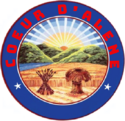Benewah
This article is incomplete because it is pending further input from participants, or it is a work-in-progress by one author. Please comment on this article's talk page to share your input, comments and questions. Note: To contribute to this article, you may need to seek help from the author(s) of this page. |
Republic of Coeur d’Alene | |
|---|---|
|
Flag | |
| Motto: "Let it be Perpetual". | |
| Anthem: "Ours To Keep" | |
| Capital | Coeur d’Alene |
| Largest city | Spokane |
| Official languages | English |
| Government | Republic by Demarchy |
• Executive | Bill Williamson |
• Executive | Ken Rost |
| Legislature | Assembly |
| Currency | Coeur d’Alene Dollar (CAD) |
| Time zone | WST |
| Date format | dd-mm-yyyy |
| Driving side | right |
| Internet TLD | .CA |
Coeur d’Alene, officially the Republic of Coeur d’Alene, is a self-proclaimed breakaway state in the Inland Northwest of North America. The Republic of Coeur d’Alene is situated on both the Spokane River and Lake Coeur d'Alene, the nation's namesake. Spokane is the country's largest metropolitan area and the city of Coeur d’Alene serves as the capital. Bolstering a population of around 3,225,000, the Republic of Coeur d’Alene's economy is dominated by farming, lumber and wood products, mining and tourism.
History
In 1992, two years after the fall of the United States, Stanley Wilson, a former Postmaster in the city of Coeur d'Alene and who became Coeur d’Alene's national hero, launched a successful independence campaign against the Idaho state authorities, who had since lost effective control over the state as a whole minus several southern border counties. Wilson had also managed to gain the backing of the independent semi-city-states of Spokane and Missoula, which had both broke away from their former states in an armed struggle.
In 1993, the new government in Coeur d’Alene convened a constituent assembly of the three cities inside the Kootenai County Courthouse, where Wilson emerged as a champion of federalism, demanding political and economic autonomy for each area. The assembly left out southern Idaho as being part of the Republic of Coeur d'Alene, and made official the inclusion of Spokane and Missoula as being official constituents of the Republic of Coeur d’Alene. The name was picked because Coeur d'Alene was the central most city between the three, and the Coeur d'Alene National Forest was seen almost as a symbol of unity.
As a result, the remnant state government in southern Idaho broke with Coeur d’Alene and joined the Union of Utah-Nevada. The Republic of Absaroka had denounced the desicion to include counties that they claim as constituents of the Republic of Coeur d’Alene. Absaroka was also a newly proclaimed republic, made up of remants of the Montana and Wyoming state governments now situated in Sheridan, Wyoming, the original proposed capitol of the state of Absaroka.
In 1993, a force of Absarokee troops invaded lands claimed by the Republic of Coeur d’Alene. This led to the 500-day-long Absarokee-Coeur d’Alene War. Neither side gained the upper hand and in 1994 the Treaty of Three Forks, fostered by the Great Plains Federation through the diplomatic efforts of the then GPF Premier George Hawkins, gave birth to the de-jure Coeur d’Alene territories. October 22 is celebrated as Independence Day, a national holiday.
Geography
The Republic is bounded by the Cascade Mountains on the west and the Rocky Mountains (following the spine of the remote and rugged Cabinet Mountains) on the east, the Blue Mountains of Oregon and foothills of the Wallowa Mountains to the south, southeast, and encompasses the Columbia river basin (or Columbia Plateau). Between the three mountain ranges are large, sweeping areas of semi-arid steppe, part of which has been irrigated due to the Columbia Basin Project, resulting in expansive farmland in western part of Coeur d'Alene. The Palouse is another major agricultural region located in the gently rolling hills of central Coeur d'Alene. In northern Coeur d'Alene, the precipitation from the Pacific Ocean over the North Central Rockies forests, create the North American inland temperate rainforest. The Coeur d'Alene Mountains of this range is noted for its natural resource wealth, particularly the Silver Valley.
Spokane, the region's largest city, is located near where the arid, and largely unforested Columbia plateau meets the lush forests of the Selkirk Mountains. The urban area stretches east into central Coeur d'Alene along the I-90 corridor through the Spokane River valley across into the cities of Post Falls and Coeur d'Alene on the north bank of Lake Coeur d'Alene. The northern portion of the Republic are mountainous and forested, and the crest of the Bitterroot Range of the Rocky Mountains forms part of the eastern boundary, while the Columbia River forms a significant part of its southern boundary.

